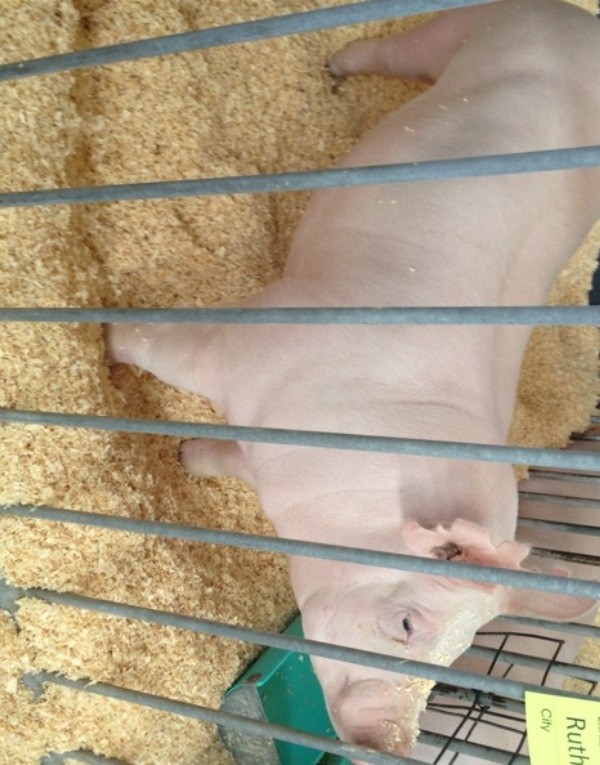Researchers who spent the past three years testing pigs for influenza A viruses at county fairs in Ohio found that infected animals commonly appear clinically normal.
October 4, 2012

Researchers who spent the past three years testing pigs for influenza A viruses at county fairs in Ohio found that infected animals commonly appear clinically normal, highlighting one of the challenges health officials faced in preventing the spread of variant influenza to humans at fairs this summer.
That was reported this week in the online edition of the Center for Infectious Disease Research & Policy (www.cidrap.umn.edu) at the University of Minnesota.
Those researchers began testing pigs at Ohio fairs in the summer of 2009 during the H1N1 influenza pandemic, and their report in an online edition of Emerging Infectious Diseases (EID) describes the flu viruses they found through the 2011 fair season.
The testing program is one of the few in the nation that has tracked flu viruses in pigs at fairs, a unique animal-human flu exposure niche that poses risks not only to humans but also to pigs and the pork industry.
In the summer of 2009, when the second wave of pandemic infections was starting in humans, veterinarians found the pandemic virus in pigs at state fairs in Minnesota and South Dakota.
This summer the group's ongoing work with Ohio fair pigs provided state and national public health officials with a unique snapshot of the swine influenza infections in this setting at a time when the number of variant flu cases in humans—most of them young fair participants—was skyrocketing. So far, 306 cases of swine-origin variant H3N2 (H3N2v) cases have been reported in humans, according to the most recent update from the Centers for Disease Control and Prevention (CDC).
Testing was conducted by scientists in The Ohio State University (OSU) Animal Influenza Ecology and Epidemiology Research Program (AIEERP) and is part of the Minnesota Center of Excellence for Influenza Research and Surveillance (MCEIRS), which receives federal funding though a national CEIRS network supported by the National Institute of Allergy and Infectious Diseases. MCEIRS is a program area in the University of Minnesota's Center for Infectious Disease Research and Policy (CIDRAP), the publisher of CIDRAP News.
During the first three years of testing, the researchers included 53 county fairs in their investigation: 15 in 2009, 16 in 2010 and 22 in 2011. Toward the end of each fair they examined all pigs at the fair and took nasal swabs from about 20 pigs from different areas of the exhibits. In total, they tested 1,073 pigs.
Over three years of testing they detected influenza A viruses in pigs at 12 (22.6%) of the 53 fairs. Pigs at 10 (83.3%) of the 12 fairs where influenza A was detected showed no signs of clinical illness.
When they analyzed virus subtypes, the group found H1N2 and H3N2 swine flu viruses in 2009. In 2010, their tests yielded H3N2 swine influenza viruses. In 2011, they found H1N2 in their samples again along with H3N2, but all isolates had the matrix (M) gene from the pandemic human 2009 H1N1virus.
Researchers told CIDRAP News that so far this summer they have detected only the H3N2 influenza A viruses again with the former pandemic virus's M gene.
The group noted that the findings show the perils of relying on visual examination to identify infected pigs that would be excluded from the fair in efforts to prevent exposure of swine and humans at the human-swine interface.
While acknowledging that agricultural fairs are a meaningful part of American history and culture and a useful way to educate people about farming and the pork industry, researchers wrote that contact with pigs at fairs can pass human viruses to pigs, which can pose a risk to the animals and then result in reassortants in pigs that can put humans at risk.
Exposure to pigs at fairs differs from exposure at commercial farms or slaughterhouses, because the events last longer and afford opportunities for mingling not only with humans, but with pigs from different locations and from other types of production systems, from backyard to commercial, the group wrote.
Andrew Bowman, DVM, lead author of the study and graduate research associate at OSU, told CIDRAP News that in 2012 the research team has continued and expanded its influenza testing project at Ohio county fairs, which start in June and continue through October.
He said the team has kept public health officials informed of its findings, working closely with human and animal health leaders in Ohio, including veterinarians with the U.S. Department of Agriculture (USDA). As reports of human H3N2v cases from several states piled up this summer, the researchers and regulatory officials often communicated their findings in pigs and people to officers from the CDC's Epidemiologic Intelligence Service (EIS).
The researchers said their findings illustrate that testing healthy pigs, not just the sick ones, in swine influenza virus surveillance programs is needed to characterize the full spectrum of influenza A viruses. Bowman said that though the flu community accepts the need to include healthy pigs in surveillance, it might be difficult to conduct that part of the testing efficiently as part of the national swine influenza testing program.
Richard Slemons, DVM, principal investigator and professor in the department of veterinary preventive medicine at OSU, told CIDRAP News that more research on fair pigs is needed to better understand the prevalence of influenza A viruses in the animals—scientific information that is crucial for guiding public health actions to mitigate the spread of illness to pigs and people.
The team has proposed some potential strategies for decreasing the prevalence of influenza A virus infections in pigs at fairs to help protect both pigs and people, which include shortening the swine exhibition period, preventing the inter-fair movement of pigs, and vaccinating fair pigs against appropriate influenza A viruses.
You May Also Like



